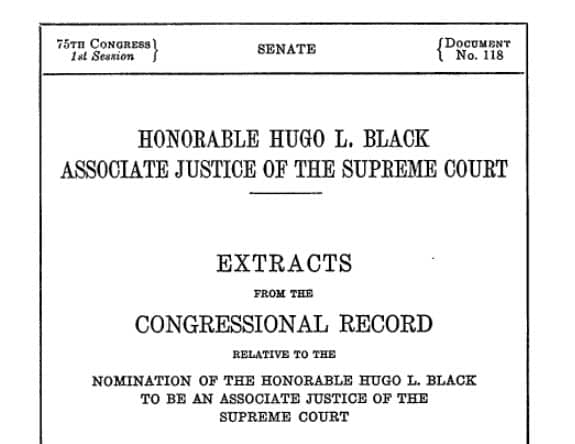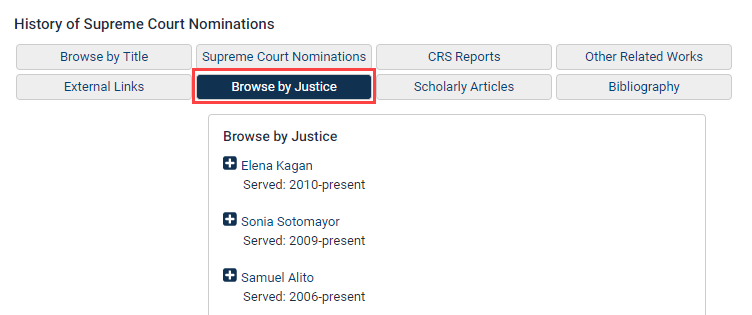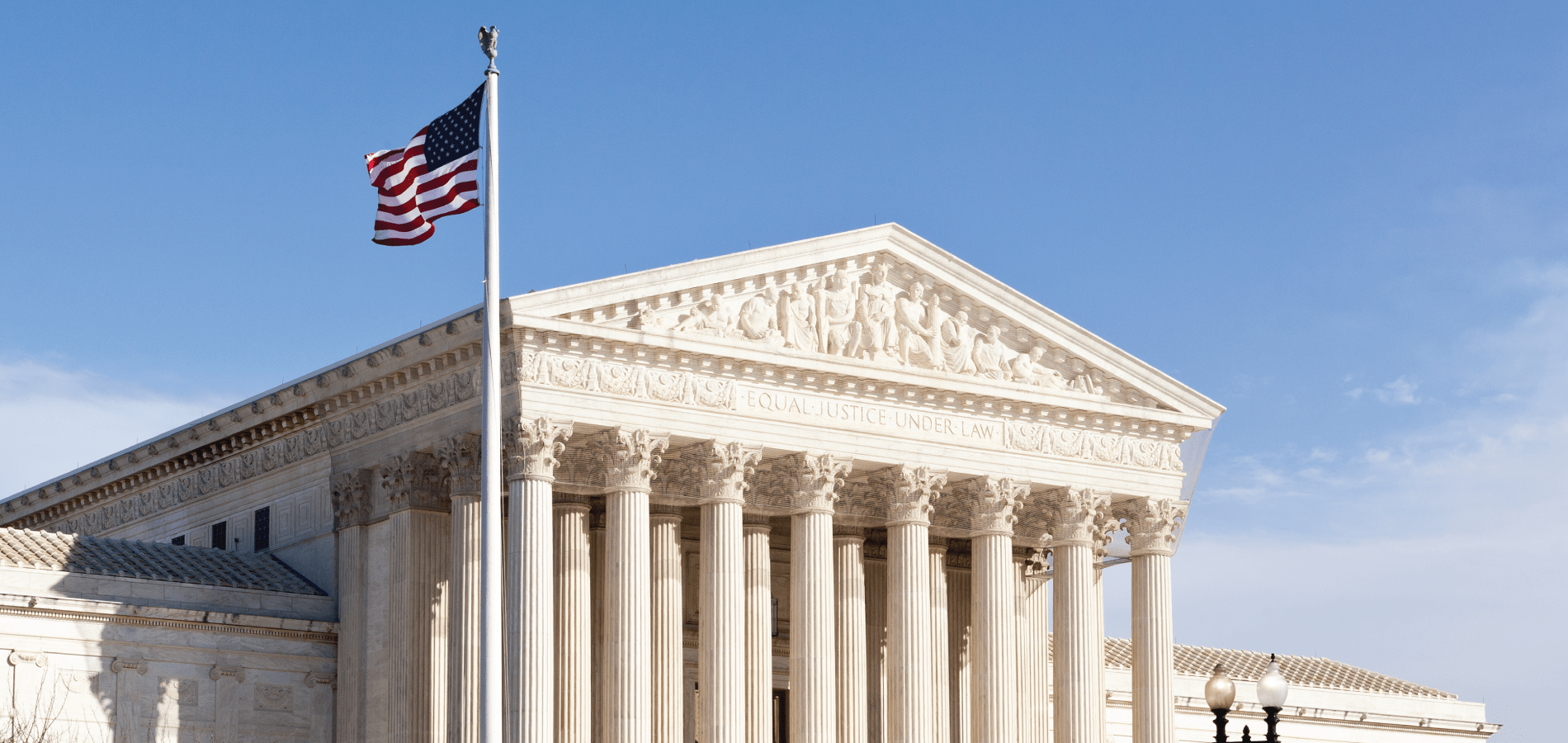Eighty-two years ago, Hugo Lafayette Black was appointed to the Supreme Court of the United States. The fifth-longest serving justice, an avid New Deal supporter, and a former Ku Klux Klansman, Hugo Black proved to be controversial yet influential in the outcome of landmark Supreme Court decisions. Read about Justice Black’s jurisprudence and Supreme Court career with HeinOnline.
Before We Get Started:
Don’t miss out! Make sure you have the databases we’ll be mentioning in this post. Follow the links below to start a trial today.
- U.S. Supreme Court Library
- History of Supreme Court Nominations
- U.S. Statutes at Large
- Pentagon Papers
- World Constitutions Illustrated
- Law Journal Library
Appointment to Associate Justice
In 1937, the first Supreme Court vacancy of Franklin D. Roosevelt ‘s presidency occurred. On August 12 of the same year, Roosevelt nominated Hugo Black for the position, an Alabama senator who had previously voted in favor of the president’s 24 major New Deal programs. Though tradition held that nominated senators would be confirmed immediately and without question, the Senate instead referred the nomination to the Judiciary Committee. Critics of Hugo Black pointed to his rumored bigotry, humble roots, and recently publicized Ku Klux Klan membership as reasons against his appointment.
On August 19, after six hours of debate, the Senate voted 63-16 to confirm Black as the newest Associate Justice of the Supreme Court. Black’s friendship with the NAACP had helped soothe concerns about his previous affiliations. Despite the win, however, Black’s appointment was again contested on his first day on the bench. Three lawyers pointed to the Ineligibility Clause of the U.S. Constitution which prevents members of Congress from holding a simultaneous position in the judicial branch. The lawyers’ concerns were dismissed in the case of Ex Parte Albert Levitt later that year.
To read first-hand about the controversy surrounding Hugo Black’s appointment, users may view the hearings and reports on his nomination in HeinOnline’s History of Supreme Court Nominations database.

Jurisprudence and Supreme Court Career
Justice Black’s distinctive legal philosophy and persistence regarding constitutional issues may have frustrated some colleagues, but also led to some of the Supreme Court’s most important decisions. A literalist, Black held the U.S. Constitution above all else and was determined to use its exact wording to restrict the role of the Court. Rather than considering a broader scope and meaning of constitutional rights, Justice Black wrote his opinions based on the plain, textual meaning of the wording in the Constitution.
Black’s literalist and absolutist jurisprudence had a significant influence on that of later justices, including Earl Warren, William Rehnquist, and Antonin Scalia. Get to know Justice Black’s stance on a few of the most important issues of his time below:
Freedom of Speech
The First Amendment of the United States Constitution reads that “Congress shall make no law respecting an establishment of religion, or prohibiting the free exercise thereof; or abridging the freedom of speech, or of the press; or the right of the people peaceably to assemble, and to petition the Government for a redress of grievances.” Over the course of his career, Justice Black took these words at face value, dissenting against any attempts by federal or state governments to undermine free speech.
For example, during the Red Scare, Black dissented in a number of cases which upheld anti-communist laws of the time. In American Communications Association v. Douds (1950), the Court upheld the Taft-Hartley Act’s imposition of an anti-communist oath on leaders of labor unions. Similarly, in Dennis v. United States, the Court upheld the Smith Act, establishing criminal penalties for those advocating the overthrow of the U.S. government.
Justice Black also advocated for the freedom of the press, rejecting the idea that the right to freedom of speech can be denied in defense of national security. In New York Times Co. v. United States (1971), Black voted in favor of allowing news outlets to publish the Pentagon Papers, though the Nixon administration argued that publication could lead to national security issues.
In cases like these, Justice Black has been considered a champion of the First Amendment. However, Black’s perspective of what actually constitutes “speech” was much more narrow than that of his colleagues. He argued that “speech” was different from “conduct,” and that conduct does not fall under First Amendment protections. Black’s viewpoint on the subject led him to dissent in Street v. New York (1969), a case upholding that it is unconstitutional to prohibit speech against the American flag. Similarly, Black dissented from the majority in Cohen v. California (1971), in which the Court upheld that clothing with the words “F*ck the Draft” was considered speech protected by the First Amendment.
Furthermore, Black did not believe that the First Amendment protects the right to speak or demonstrate anywhere at any time. In Adderley v. Florida (1966), he wrote the majority opinion upholding that it is constitutional to arrest protestors on government property. In Tinker v. Des Moines (1969), Black dissented against the majority opinion that public school officials cannot censor students’ speech, whether literal or symbolic, unless the justification for censorship is constitutionally valid.
Civil Rights
Though a former member of the KKK and initially rumored a bigot, Black established himself as sympathetic to the civil rights movement over the course of his Supreme Court career. Perhaps most notably, Justice Black was part of the unanimous Brown v. Board of Education (1954) landmark decision upholding that racial segregation in public schools is unconstitutional. In the same vein, Black recommended that the Court favor “immediate desegregation” in Alexander v. Holmes County Board of Education (1969).
Despite being part of these important decisions in favor of the civil rights movement, Black held the rule of law higher than the importance of individual civil rights. As the majority opinion writer in Korematsu v. United States, for example, he helped validate President Roosevelt’s order that all Japanese-Americans relocate to internment camps following Japan’s attack on Pearl Harbor.
Church and State
Justice Black’s absolutist approach to interpreting the First Amendment led him to fervently support a separation between church and state. As a result, he wrote several majority opinions relating to the topic:
- In Everson v. Board of Education (1947), he delivered the Court’s opinion that the Establishment Clause in the Bill of Rights—”Congress shall make no law respecting an establishment of religion”—also applies to state governments.
- In McCollum v. Board of Education (1948), Black’s majority opinion held that neither state nor federal governments could support religious instruction in public schools.
- In Torcaso v. Watkins (1961), the Court declared it unconstitutional for states to use religious tests as qualifications for public office.
- In Engel v. Vitale (1962), Black delivered the majority opinion of the Court that it is unconstitutional for states to require or encourage the recitation of prayer in public schools.
Justice Black’s jurisprudence was not limited to the issues above. During his Supreme Court term, Black wrote opinions on many cases covering a variety of topics such as voting rights, due process, criminal procedure—including the landmark decisions of Gideon v. Wainwright and Miranda v. Arizona—and more.
To find relevant works on Hugo Black, users may visit HeinOnline’s History of Supreme Court Nominations. Select “Browse by Justice” and choose “Hugo Black” from the list of options to view available related works.


Users may continue their research on Justice Black’s legal philosophy in the Law Journal Library. From the database home page, perform a full-text search for “hugo black” AND jurisprudence to view nearly 3,700 related results. Further refine the search using the facets on the left-hand side of the results. For example, under “Person,” select Hugo Black to view nearly 320 results, including:
- Telling Stories about Constitutional Law
- Justice Hugo L. Black: A Magnificent Product of the South
- The Conflicted Constitution: The Textual Absolutism of Justices Black and Thomas versus the Balanced Restraint of Justices Frankfurter and Breyer
- Hugo Black and Judicial Lawmaking: Forty Years in Retrospect
Finally, read the words of Hugo Black himself in HeinOnline. Head to Justice Black’s author profile page to view 16 available articles, including his article entitled The Bill of Rights (itself cited by more than 530 HeinOnline articles). In addition, use the new Explore This Author tool to view Justice Black’s most-discussed topics, related authors, and more.

Like what you see? Receive informative blog posts right in your inbox by clicking Subscribe at the top of this post.
Don’t forget to connect with HeinOnline on our social media platforms: Facebook, Twitter, Instagram and YouTube.



